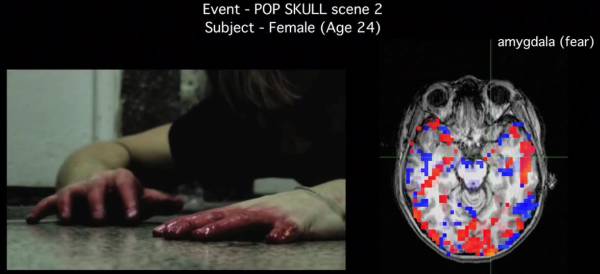Brain scans from viewers will change filmmaking
In Hollywood, they decided to learn from the experience of neuromarketing and began to use magnetic resonance scanners (fMRI) to study how much individual scenes of feature films affect the human brain. Theoretically, this can increase the level of emotional impact by an order of magnitude and bring the cinema to a new stage of development.
One of the leaders in the new neurokino direction (neurocinema) is MindSign Neuromarketing , which was founded by film producer Peter Katz and neurologist Dr. David Hubbard. Recently, they completed the first stage of research, which made a complete picture of the impact on the human cerebellum of two scenes from the horror movie “Skull on Wheels” , with a storyboard of the four main cerebellar emotions (disgust, anger, lust and fear) in seconds, Wired writes .

')
For example, the results of the test allowed us to reveal, up to the frame, the most terrible moment of the film (see the video under Habrakat).
The experiment was conducted on a 24-year-old woman, using a Siemens 3T MRI scanner for tests, the duration of the sessions was 48 s and 68 s. Data processing took place in the BrainMovie program (it gives the same colored scans of the brain as in the TV series "Doctor House"). As Wired writes, while watching a movie, the woman's cerebellum glows like a Christmas tree.
The second video contains scenes of violence.
If such technologies will be used in the filming of films, then the future of cinema is even frightening to imagine.
One of the leaders in the new neurokino direction (neurocinema) is MindSign Neuromarketing , which was founded by film producer Peter Katz and neurologist Dr. David Hubbard. Recently, they completed the first stage of research, which made a complete picture of the impact on the human cerebellum of two scenes from the horror movie “Skull on Wheels” , with a storyboard of the four main cerebellar emotions (disgust, anger, lust and fear) in seconds, Wired writes .

')
For example, the results of the test allowed us to reveal, up to the frame, the most terrible moment of the film (see the video under Habrakat).
The experiment was conducted on a 24-year-old woman, using a Siemens 3T MRI scanner for tests, the duration of the sessions was 48 s and 68 s. Data processing took place in the BrainMovie program (it gives the same colored scans of the brain as in the TV series "Doctor House"). As Wired writes, while watching a movie, the woman's cerebellum glows like a Christmas tree.
The second video contains scenes of violence.
Two videos in a ZIP-archive (codec H264, 1280x720, 70.1 MB).
If such technologies will be used in the filming of films, then the future of cinema is even frightening to imagine.
Source: https://habr.com/ru/post/70550/
All Articles